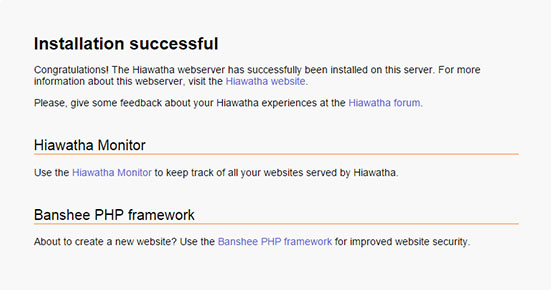
In this tutorial, we will show you how to install and configure of Hiawatha web server on your Ubuntu 16.04 server. For those of you who didn’t know, Hiawatha is a web server built with a focus on security. It has built-in rules that can prevent cross-site scripting and forgery, SQL injections, and resource expenditure. Although its focus is on security, it also excels in performance due to its lightweight design. When combining the Hiawatha web server with PHP-FPM and MySQL, you can have a powerful web server that is both lightweight and secure.
This article assumes you have at least basic knowledge of Linux, know how to use the shell, and most importantly, you host your site on your own VPS. The installation is quite simple and assumes you are running in the root account, if not you may need to add ‘sudo‘ to the commands to get root privileges. I will show you the step-by-step installation of Hiawatha on a Ubuntu 16.04 (Xenial Xerus) server.
Hiawatha Features
- CGI and load balancing FastCGI support
- Large file support
- Reverse proxy functionality
- Chroot support
- URL toolkit which supports URL rewriting
- SSL and TLS support
- Basic and Digest HTTP authentication
- Upload speed control by traffic shaping
- Internal file caching
- IPv6 support
- HTTP compression using gzip
- Virtual hosting
- Support for WebDAV applications
- Support for Server Name Indication included in v8.6
Prerequisites
- A server running one of the following operating systems: Ubuntu 16.04, and any other Debian-based distribution like Linux Mint.
- It’s recommended that you use a fresh OS install to prevent any potential issues.
- SSH access to the server (or just open Terminal if you’re on a desktop).
- A
non-root sudo useror access to theroot user. We recommend acting as anon-root sudo user, however, as you can harm your system if you’re not careful when acting as the root.
Install Hiawatha Web Server on Ubuntu 16.04
Step 1. First, make sure that all your system packages are up-to-date by running the following apt-get commands in the terminal.
sudo apt-get update sudo apt-get upgrade
Step 2. Installing Hiawatha Web Server.
First, get and install the repository’s public key:
apt-key adv --recv-keys --keyserver keys.gnupg.net 79AF54A9 nano /etc/apt/sources.list
Add the following to sources.list:
deb http://mirror.tuxhelp.org/debian/ squeeze main
Install Hiawatha with the following command:
apt-get update apt-get install hiawatha
Start Hiawatha and add it to automatically start on your system start-up using:
systemctl enable hiawatha.service systemctl start hiawatha.service
You can verify that the Hiawatha webserver is really running by opening your favorite web browser and entering the URL http://your-IP's-address if it is installed, then you will see this:

Using the default settings, you can put your web content in the following directory:
/var/www/hiawatha
For any configuration changes that you may want to make, you can go to the following directory:
/etc/hiawatha
Congratulations! You have successfully installed Hiawatha. Thanks for using this tutorial for installing the Hiawatha web server in Ubuntu 16.04 (Xenial Xerus) LTS systems. For additional help or useful information, we recommend you check the official Hiawatha website.